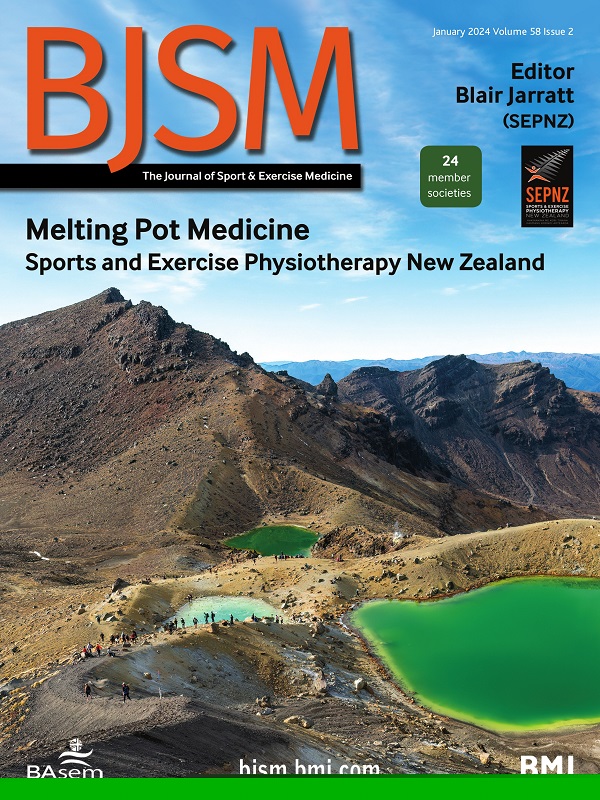Concussion and depressive symptoms in high school students: impact of physical activity and substance use
IF 11.6
1区 医学
Q1 SPORT SCIENCES
引用次数: 0
Abstract
Objective To investigate the association between concussion history and depressive symptoms after adjusting for physical activity, substance use, and illicit drug use. Methods We analysed data from the Adolescent Behaviour and Experiences Survey, a nationally representative survey of adolescents in the USA. Our independent variables were history of concussion in the 12 months preceding survey completion; self-reported weekly physical activity (days per week with >60 min of physical activity, 0–7 scale); substance use over the past 30 days (yes vs no) and illicit drug use throughout lifetime (yes vs no). Our dependent variable was participant-reported sadness/hopelessness over the past 12 months (yes vs no). Results Among 7499 adolescents (9th–12th grade, 50.4% female), reporting one or more concussions over the past year was not associated with the odds of depressive symptoms (OR: 1.13, 95% CI: 0.93 to 1.37, p=0.21). Each additional day of physical activity per week was associated with a lower odds of depressive symptoms (OR: 0.91; 95% CI: 0.89 to 0.94; p<0.0001). Illicit drug use (OR ever vs never: 2.48; 95% CI: 1.96 to 3.13; p<0.0001) and substance use (OR yes vs no: 2.77; 95% CI: 2.34 to 3.29; p<0.001) were associated with a higher odds of depressive symptoms. Conclusions Adjusting for physical activity, substance use and illicit drug use, concussion was not significantly associated with depressive symptoms. This novel discovery informs clinicians as they counsel adolescents with concussion; future research should examine physical activity and avoidance of substance/illicit drug use as postinjury recommendations in an effort to lower the risk of depressive symptoms. Data are available in a public, open access repository. We analysed data from the Adolescent Behaviour and Experiences Survey (ABES), a nationally representative survey of health and behavioural-related outcomes among adolescents. The ABES is a stratified, three-stage cluster probability-based survey which enrolled adolescent-aged high school students in public and private schools across the USA.高中生的脑震荡和抑郁症状:体育活动和物质使用的影响
目的 研究脑震荡史与抑郁症状之间的关系,并对体育锻炼、药物使用和非法药物使用进行调整。方法 我们分析了 "青少年行为与经历调查"(Adolescent Behaviour and Experiences Survey)的数据,这是一项针对美国青少年进行的具有全国代表性的调查。我们的自变量是调查完成前 12 个月内的脑震荡病史;自我报告的每周体育活动量(每周体育活动量大于 60 分钟的天数,0-7 分制);过去 30 天内的药物使用情况(是与否)以及一生中的非法药物使用情况(是与否)。我们的因变量是参与者报告的过去 12 个月的悲伤/无望情绪(是与否)。结果 在 7499 名青少年(9-12 年级,50.4% 为女性)中,在过去一年中报告过一次或多次脑震荡与出现抑郁症状的几率无关(OR:1.13,95% CI:0.93 至 1.37,P=0.21)。每周每增加一天体育锻炼,抑郁症状出现的几率就会降低(OR:0.91;95% CI:0.89 至 0.94;p<0.0001)。使用非法药物(OR 曾经使用 vs 从未使用:2.48;95% CI:1.96 至 3.13;p<0.0001)和使用药物(OR 是 vs 否使用:2.77;95% CI:2.34 至 3.29;p<0.001)与抑郁症状发生几率较高有关。结论 在对体育锻炼、药物使用和非法药物使用进行调整后,脑震荡与抑郁症状并无明显关联。这一新颖的发现为临床医生为患有脑震荡的青少年提供咨询提供了参考;未来的研究应将体育锻炼和避免使用药物/违禁药物作为伤后建议,以努力降低抑郁症状的风险。数据可在公开、开放的资料库中获取。我们分析了青少年行为和经历调查(ABES)的数据,这是一项针对青少年健康和行为相关结果的全国代表性调查。ABES 是一项基于概率的分层三阶段群组调查,调查对象为美国公立和私立学校中的青春期中学生。
本文章由计算机程序翻译,如有差异,请以英文原文为准。
求助全文
约1分钟内获得全文
求助全文
来源期刊
CiteScore
27.10
自引率
4.90%
发文量
217
审稿时长
3-8 weeks
期刊介绍:
The British Journal of Sports Medicine (BJSM) is a dynamic platform that presents groundbreaking research, thought-provoking reviews, and meaningful discussions on sport and exercise medicine. Our focus encompasses various clinically-relevant aspects such as physiotherapy, physical therapy, and rehabilitation. With an aim to foster innovation, education, and knowledge translation, we strive to bridge the gap between research and practical implementation in the field. Our multi-media approach, including web, print, video, and audio resources, along with our active presence on social media, connects a global community of healthcare professionals dedicated to treating active individuals.

 求助内容:
求助内容: 应助结果提醒方式:
应助结果提醒方式:


